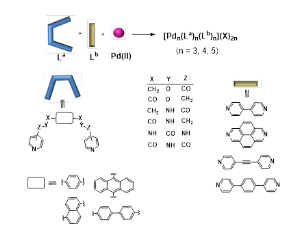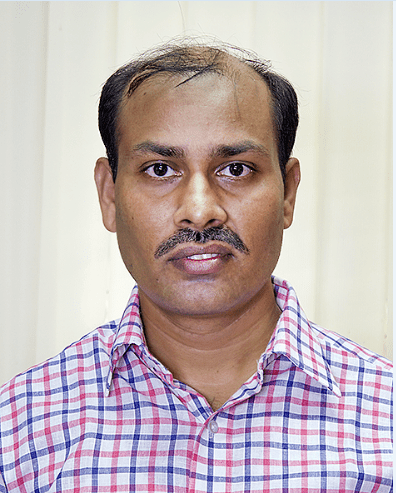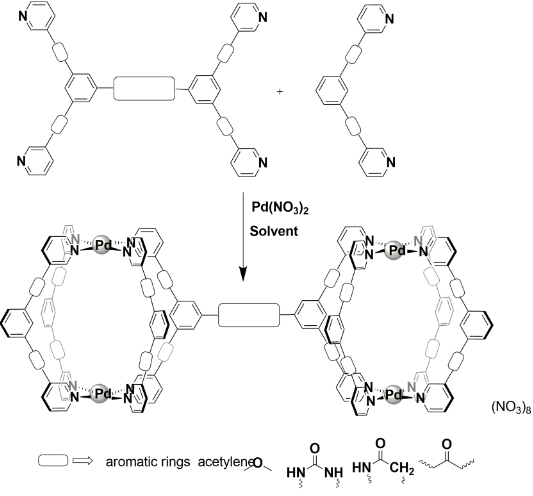Project
To prepare multi-compartmental coordination cages of general formulations MmLn and MmLanLbo where M stands for palladium(II)/platinum(II) and L/La/Lb for chosen bi/poly dentate designed ligands, respectively.
To use the homoleptic (containing one type of ligand) and heteroleptic cages (containing more than one type of ligands) for cooperative guest binding and further reactivity.
To prepare supramolecular porous gel using coordination cages and use the soft matter for catalysis, binding and separation studies. Self-assembly of already self-assembled cage will be studied as tectons in crystal engineering.
To perform computational studies like energy minimization and molecular dynamics to unveil the architectural preferences and pathways involved.
Ligands: The “wavy-shaped” ligand design is based on two terminal pyridine rings and one or more internal pyridine rings or no internal ring. The spacer will be crafted in such a way that the coordination vectors will remain parallel to each other. A spacer within a ligand backbone may or may not be the same as the other. Only representative designs are shown in the Figure. The ligands will be synthesized using protocols of organic synthesis. The smallest ligand will be a bidentate in nature when n=0 and polydentate when n>0. For the bidentate ligand, we expect to prepare cages with one 3-D cavity and multicavity cages are expected from the polydentate ligands. The length and width of the cavities will be modulated by suitably choosing the spacer units.
Homoleptic multi-compartmental 3-D cages:
The synthesis of multi cavity cages would involves the complexation of palladium(II) with various functionalized ligands in appropriate ratio under suitable condition and further encapsulation of the cages with suitable guests as shown in Figure. Depending on the orientation of the functional groups towards inside or outside of the cage, the cages would show the binding of different guests e.g. anions or cations. For example, hydrogen bond donors/acceptors abilities of urea will make the cavity ideal for binding study. Depending upon the cage-cavity, guest will be designed and vice versa. Guest-induced host formation will be explored. The dynamic nature of metal-ligand bonding will be followed in solution state for understanding the mechanistic aspects of cage formation and guest binding.
Heteroleptic multi-compartmental 2-D cages:
We propose design of palladium(II) based heteroleptic self-assembled complexes possessing multi-cavities. Such complexes can be prepared by one-pot complexation of palladium(II) with a wavy and a rigid ligand as shown and utilised for host guest binding study. The bidentate wavy ligand and bidentate rigid ligand can be prepared by usual techniques. Combination of equal ratio of both ligands and palladium(II) salts will result in the formation of tri, tetra or pentanuclear self-assembled complexes possessing multi cavities depending upon ligand design.


Supramolecular Gel:
Single crystals of self-assembled coordination cages can display further Self-assembly that can be deciphered from its packing. When the packing favours entanglement, there is a possibility of gel formation. The supramolecular gel so prepared using coordination cages will have cavity containing entities and hence porous nature. To achieve this goal, the self-assembled molecule should possess functional groups which support the non-covalent interactions. By keeping all these in mind, we have selected naphthalene diimide (NDI) based ligands which can promote π–π stacking and H-bonding. The ligand can be easily synthesis from the available chemicals like NDI, urea or amide containing pyridine moieties. Combination of palladium(II) with NDI based bi and tridentate ligands(II) will afford binuclear and trinuclear cages with one and two cavities, respectively. The gel material will be characterized by NMR, UV-vis spectroscopy, PXRD, SEM, TEM, AFM, DLS, and rheology measurements. We intend to use these in heterogeneous catalysis in reduction, C-C bond coupling, in encapsulation of guest molecules, and removal of pollutants from water such as dye molecules.
Helicate type architectures as tectons:
The synthesis of imidazole, triazole and tetrazole based ligands will be prepared by simple nucleophilic substitution reaction. By combining the ligand with the cis-protected palladium(II) component can generate Pd2L′2L2 or and Pd3L′3L3 depending as the preliminary result obtained by us. The ligand design, and cis-protecting agent might work in synergy to result helical and non-helical structures and this aspects will be explored . We are also looking into the nature of such complexes as tectons in crystal engineering. It will be interesting to explore the helical compounds as tectons in the same view point. We already have preliminary result on helicate formation.
Connecting two cages:
Bridging two self-assembled Pd2L4 cages can make the double cavity containing [Pd2L4]2 , which will be novel design in the supramolecular chemistry . This section includes the design and synthesis of a suitable ligand efficient for the synthesis of the desired supramolecular architecture. The ligand should have strong binding affinity toward the metal keeping this in mind we have incorporated pyridine as the coordinating sites. The electronics of such system can be tuned very easily by introducing functional groups or changing substituents at the ligand backbone. Synthesis of the ligand can be done using standard coupling reactions between the corresponding groups. Depending on the substituents attached the designed ligand would be a rigid entity and expected to give discrete product upon reaction with appropriate equivalent of both the ligands and metal under suitable condition. The final metallosupramolecular cage would be a unique variety of Pd4La6Lb1 moiety which is expected to inherent the characteristics of the parent Pd2L4 species, but with subtle modifications.
Expected deliverables of the research
The research results will be published in high quality journals and presented in conferences. We have been attending attend National and International seminars for delivering talks and presentation poster and hence visible in the community. Modern Trends in Inorganic Chemistry (MTIC) is the major even in India, also attended by selected International Speakers. International Conference on Coordination Chemistry (ICCC), and International Symposium on Macrocyclic and Supramolecular Chemistry (ISMSC) are the two major events at International level. We believe to make impact of our research result and keep the name of IIT Madras high.Current status
- Literature search and palnning is in progress. Once the labs are reopend we will execute the experimental part.
Collaborations
International Collaborations
We initiated collaboration with Prof. Michito Yoshizawa of Tokyo Institute of Technology and Prof. Garry Hanan of University of Montreal. We will continue the collaboration. Active collaboration with other groups will be explored as the situation improves.
Societal impact
Sustenance statement
Support will be sought from SERB for projects.
Reference
https://cen.acs.org/articles/95/i49/molecules-of-the-year-2017.html
http://www.thehindu.com/sci-tech/science/star-molecule-from-iit-m/article22536484.ece
https://alumni.iitm.ac.in/tech-talk/cracking-the-natures-code-of-self-assembly/



